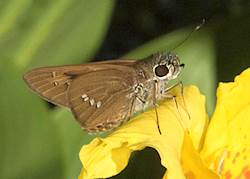Canna leafroller, Calpodes ethlius. Also known as the Larger Canna Leafroller. The Lesser Canna Leafroller, Geshna cannalis, also feeds on Canna plants.
My Cannas are in tatters. This is the worst I have seen them in years which is one of the reasons I don’t grow many cannas. I have bronze leaves Cannas with red flowers for which I don’t have a name as these were pass-a-long plants and a few Bengal Tiger Cannas, a cultivar with bright green leaves, yellow stripes, and orange flowers. Even Canna indica, known as Indian Shot or Queensland Arrowroot has not been spared.
When in bloom these cannas are quite striking. For most of the summer my Cannas looked great until August. While all my cannas are in the ground I have a combination, Bengal Tiger and Bronze leaf in a tall container which is where I first noticed the rolled-up edge of a piece of the leaf. Curious, I peeled back the leaf flap which looks like a taco and found this translucent pale green caterpillar with a large dark head approximately 1 inch long.
The female Brazilian Skipper Butterfly lays eggs singly or in groups of five to seven spaced apart on the upper surface of the canna leaf. At the first instar stage the larva eats two thin strips of the leaf and forms a leaf flap which is fastened with silk treads. As it outgrows its leaf flap it moves to another area to create a larger leaf flap. After the fifth instar it forms a silken mat and begins to pupate within its shelter. The chrysalis is light green and covered with a powdery white substance.

Picture by Alabama usf.edu
The Brazilian Skipper Butterfly has a wingspan of 1 ¾ to 2 ¼ inches and is a deep brown in color. It is native to Mexico, Central America and the northern part of South America and has established itself in Texas and Southern Florida but can be found in other parts of the U.S. They are strong fliers and seen sipping nectar from flowers at dusk.